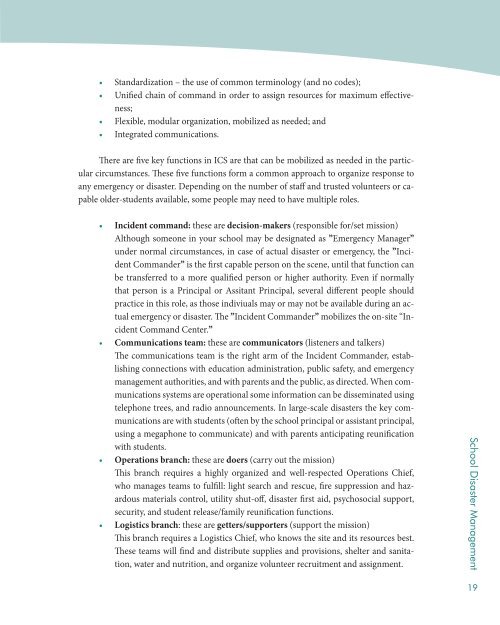Disaster and Emergency Preparedness: Guidance for ... - INEE Toolkit
Disaster and Emergency Preparedness: Guidance for ... - INEE Toolkit
Disaster and Emergency Preparedness: Guidance for ... - INEE Toolkit
You also want an ePaper? Increase the reach of your titles
YUMPU automatically turns print PDFs into web optimized ePapers that Google loves.
St<strong>and</strong>ardization – the use of common terminology (<strong>and</strong> no codes);Unified chain of comm<strong>and</strong> in order to assign resources <strong>for</strong> maximum effectiveness;Flexible, modular organization, mobilized as needed; <strong>and</strong>Integrated communications.There are five key functions in ICS are that can be mobilized as needed in the particularcircumstances. These five functions <strong>for</strong>m a common approach to organize response toany emergency or disaster. Depending on the number of staff <strong>and</strong> trusted volunteers or capableolder-students available, some people may need to have multiple roles.Incident comm<strong>and</strong>: these are decision-makers (responsible <strong>for</strong>/set mission)Although someone in your school may be designated as ”<strong>Emergency</strong> Manager”under normal circumstances, in case of actual disaster or emergency, the ”IncidentComm<strong>and</strong>er” is the first capable person on the scene, until that function canbe transferred to a more qualified person or higher authority. Even if normallythat person is a Principal or Assitant Principal, several different people shouldpractice in this role, as those indiviuals may or may not be available during an actualemergency or disaster. The ”Incident Comm<strong>and</strong>er” mobilizes the on-site “IncidentComm<strong>and</strong> Center.”Communications team: these are communicators (listeners <strong>and</strong> talkers)The communications team is the right arm of the Incident Comm<strong>and</strong>er, establishingconnections with education administration, public safety, <strong>and</strong> emergencymanagement authorities, <strong>and</strong> with parents <strong>and</strong> the public, as directed. When communicationssystems are operational some in<strong>for</strong>mation can be disseminated usingtelephone trees, <strong>and</strong> radio announcements. In large-scale disasters the key communicationsare with students (often by the school principal or assistant principal,using a megaphone to communicate) <strong>and</strong> with parents anticipating reunificationwith students.Operations branch: these are doers (carry out the mission)This branch requires a highly organized <strong>and</strong> well-respected Operations Chief,who manages teams to fulfill: light search <strong>and</strong> rescue, fire suppression <strong>and</strong> hazardousmaterials control, utility shut-off, disaster first aid, psychosocial support,security, <strong>and</strong> student release/family reunification functions.Logistics branch: these are getters/supporters (support the mission)This branch requires a Logistics Chief, who knows the site <strong>and</strong> its resources best.These teams will find <strong>and</strong> distribute supplies <strong>and</strong> provisions, shelter <strong>and</strong> sanitation,water <strong>and</strong> nutrition, <strong>and</strong> organize volunteer recruitment <strong>and</strong> assignment.School <strong>Disaster</strong> Management19
















